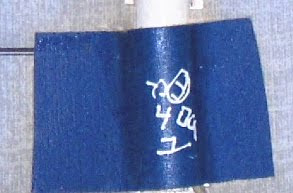The spine label is not a lost library skill, but some earlier methods are no longer used. The challenge is that no one label fits all the needs. [fn 1] Libraries need labels that are inexpensive to create and apply, stick to books, easily removable, never damage the book, and never fades, dries out or deteriorates. Such a label doesn't exist. One must choose which of these qualities is most important.
Let’s examine the situation.
Naysayers are telling us that electronic books are so easy to buy that people will no longer need libraries. In her September 14th blog, [fn 2] “The Annoyed Librarian” wrote that the public libraries are doomed. She claims that electronic books will replace the need for anything from a library..
Amazon may drive libraries out of business the way it did a lot of bookstores, and the only ones likely to be disappointed are the librarians. Everyone else will be too busy reading whatever book they want, watching whatever movie or TV show they want, and listening to any music they want.
How does this relate to labels? Cataloging a collection building are what separates a bunch of books from a library. In the first picture below is a shelf of books. They are ordered alphabetically by title, but they have not been cataloged, systematically acquired or labeled. Note there are two copies of one of the titles.
I am sure that the average person will have no trouble buying a few books in electronic format for recreational reading. Libraries spend a lot of time building collections. This is a daunting task. According to R.R. Bowker publisher of Book in Print, the record of all commercial book publishing in the United States , [fn 3] 316,480 titles were projected in traditional formats, and 2,7776,260 titles were non-traditional (according to Bowker reprints, public domain, and print on demand) This does not include titles published by organizations and governmental bodies that are not in the commercial book trade. In 1993 there were 104,124 titles published. [fn 4] The biggest academic libraries purchase 50,000 or more titles per year from world-wide sources. Someone has to select and approve those purchases. Depending on how you use the numbers, they are purchasing less than 2% of the titles that Bowker lists. This does not even include titles from other countries.
Once the books are in the library and cataloged they need labels. A long time ago, even before I was in college, librarians were taught a type of writing called “library hand.” The two pictures below have spines written by hand. In the blue label, I can not even read the whole label. The first line looks as if letters were written on top of each other to correct a mistake. The second line could be a class number. The book is in Hebrew and the last line corresponds to the author’s last name. This was written on blue tape that is now old and no longer sticks to the book.
This label is written on a spine that was repaired. The tape is still viable.
Label making gradually became more systematic to ensure uniformity. In the picture of a shelf below there are four kinds of paper labels, 1) Vendor supplied as part of a catalog kit, 2) Typewritten on paper using an electric typewriter, 3) Typewritten with a computer word processing program; and 4) Prepared automatically with the library management system. The later two are indistinguishable on the spine. Paper labels are easy to prepare and have good durability for my home collection. They are covered with permanent tape. Some labels applied in the late 1960’s are still in excellent condition. They have not faded, dried out, yellowed, or fallen off. The computer prepared labels are bigger and more readable and use the same paper base with tape for protection. They last better than labels printed on label stock.
Durability is a big concern in libraries. They need labels that won’t fade or fall off. Sellin labels were typed from a roll of tape and later dot matrix printed. The labels had a white surface for the text and an adhesive back. The adhesive was heat activated. Below is a picture of the iron and the process of heating the label. The label was applied to the book and then the iron was applied to heat adhesive. The labels were durable and were hard to remove. Over time the letters faded.
There is no perfect label. For ease of preparation and economy I choose paper labels for my home collection. For ease of production of labels in the library I choose to print the labels on label stock. I know those labels will age and fall off, but I hope by that time we will have found another solution.
==========
Notes:
1. This article is supposed to be tongue in cheek. For a more serious discussion of labels see “The Quest for the Perfect Spine Label” by Cheryl D. Walters. http://www.computype.com/en/Case%20Studies/Spine-Label-Printing-System.aspx?src=Libraries.
2. “Public Libraries are Doomed” in The Annoyed Librarian blog found in Library Journal Sept. 14, 2011. http://blog.libraryjournal.com/annoyedlibrarian/2011/09/14/public-libraries-are-doomed/
3. See” New Book totals and editions, 2002-2010”.
http://www.bowkerinfo.com/pubtrack/AnnualBookProduction2010/ISBN_Output_2002-2010.pdf
4. U.S. Book Production. http://www.bowker.com/bookwire/decadebookproduction.html







